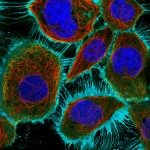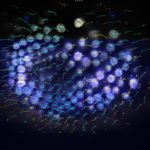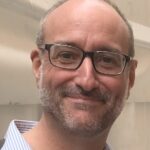Link to Pubmed [PMID] – 23450621
Link to DOI – 10.1002/bies.201200132
Bioessays 2013 May; 35(5): 472-81
When a cell divides, it produces two daughter cells initially connected by a cytokinesis bridge, which is eventually cut through abscission. One of the two daughter cells inherits a bridge “remnant”, which has been proposed to be degraded by autophagy. The fate and function of remnants is attracting increasing attention, as their accumulation appears to influence proliferation versus differentiation of the daughter cells. Here, we present a simple model for bridge and remnant turnover in a dynamic cell population. We demonstrate that remnant proportions depend on the ratio of remnant and bridge lifetimes to the cell population doubling time. Our results yield new alternative interpretations for published experimental data, leading us to believe that autophagy-independent pathways for remnant degradation may exist. In addition, using the model, we determined experimentally inaccessible parameters such as remnant lifetime. Our model proves to be a useful tool for studying bridge and remnant populations.




